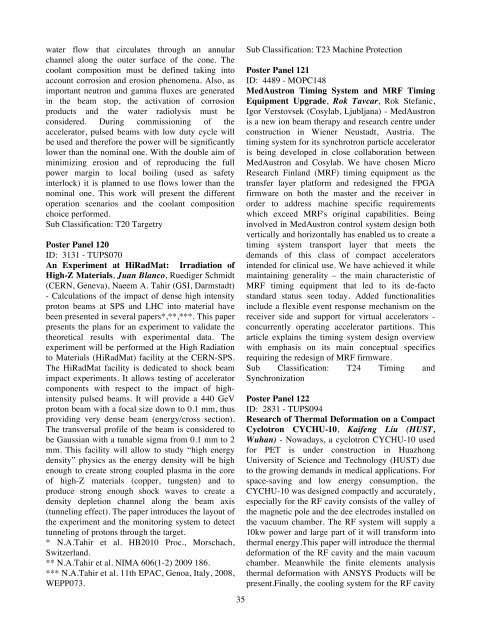Abstracts Brochure - 2nd International Particle Accelerator Conference
Abstracts Brochure - 2nd International Particle Accelerator Conference
Abstracts Brochure - 2nd International Particle Accelerator Conference
You also want an ePaper? Increase the reach of your titles
YUMPU automatically turns print PDFs into web optimized ePapers that Google loves.
water flow that circulates through an annular<br />
channel along the outer surface of the cone. The<br />
coolant composition must be defined taking into<br />
account corrosion and erosion phenomena. Also, as<br />
important neutron and gamma fluxes are generated<br />
in the beam stop, the activation of corrosion<br />
products and the water radiolysis must be<br />
considered. During commissioning of the<br />
accelerator, pulsed beams with low duty cycle will<br />
be used and therefore the power will be significantly<br />
lower than the nominal one. With the double aim of<br />
minimizing erosion and of reproducing the full<br />
power margin to local boiling (used as safety<br />
interlock) it is planned to use flows lower than the<br />
nominal one. This work will present the different<br />
operation scenarios and the coolant composition<br />
choice performed.<br />
Sub Classification: T20 Targetry<br />
Poster Panel 120<br />
ID: 3131 - TUPS070<br />
An Experiment at HiRadMat: Irradiation of<br />
High-Z Materials, Juan Blanco, Ruediger Schmidt<br />
(CERN, Geneva), Naeem A. Tahir (GSI, Darmstadt)<br />
- Calculations of the impact of dense high intensity<br />
proton beams at SPS and LHC into material have<br />
been presented in several papers*,**,***. This paper<br />
presents the plans for an experiment to validate the<br />
theoretical results with experimental data. The<br />
experiment will be performed at the High Radiation<br />
to Materials (HiRadMat) facility at the CERN-SPS.<br />
The HiRadMat facility is dedicated to shock beam<br />
impact experiments. It allows testing of accelerator<br />
components with respect to the impact of highintensity<br />
pulsed beams. It will provide a 440 GeV<br />
proton beam with a focal size down to 0.1 mm, thus<br />
providing very dense beam (energy/cross section).<br />
The transversal profile of the beam is considered to<br />
be Gaussian with a tunable sigma from 0.1 mm to 2<br />
mm. This facility will allow to study “high energy<br />
density” physics as the energy density will be high<br />
enough to create strong coupled plasma in the core<br />
of high-Z materials (copper, tungsten) and to<br />
produce strong enough shock waves to create a<br />
density depletion channel along the beam axis<br />
(tunneling effect). The paper introduces the layout of<br />
the experiment and the monitoring system to detect<br />
tunneling of protons through the target.<br />
* N.A.Tahir et al. HB2010 Proc., Morschach,<br />
Switzerland.<br />
** N.A.Tahir et al. NIMA 606(1-2) 2009 186.<br />
*** N.A.Tahir et al. 11th EPAC, Genoa, Italy, 2008,<br />
WEPP073.<br />
�<br />
35<br />
Sub Classification: T23 Machine Protection<br />
Poster Panel 121<br />
ID: 4489 - MOPC148<br />
MedAustron Timing System and MRF Timing<br />
Equipment Upgrade, Rok Tavcar, Rok Stefanic,<br />
Igor Verstovsek (Cosylab, Ljubljana) - MedAustron<br />
is a new ion beam therapy and research centre under<br />
construction in Wiener Neustadt, Austria. The<br />
timing system for its synchrotron particle accelerator<br />
is being developed in close collaboration between<br />
MedAustron and Cosylab. We have chosen Micro<br />
Research Finland (MRF) timing equipment as the<br />
transfer layer platform and redesigned the FPGA<br />
firmware on both the master and the receiver in<br />
order to address machine specific requirements<br />
which exceed MRF's original capabilities. Being<br />
involved in MedAustron control system design both<br />
vertically and horizontally has enabled us to create a<br />
timing system transport layer that meets the<br />
demands of this class of compact accelerators<br />
intended for clinical use. We have achieved it while<br />
maintaining generality – the main characteristic of<br />
MRF timing equipment that led to its de-facto<br />
standard status seen today. Added functionalities<br />
include a flexible event response mechanism on the<br />
receiver side and support for virtual accelerators -<br />
concurrently operating accelerator partitions. This<br />
article explains the timing system design overview<br />
with emphasis on its main conceptual specifics<br />
requiring the redesign of MRF firmware.<br />
Sub Classification: T24 Timing and<br />
Synchronization<br />
Poster Panel 122<br />
ID: 2831 - TUPS094<br />
Research of Thermal Deformation on a Compact<br />
Cyclotron CYCHU-10, Kaifeng Liu (HUST,<br />
Wuhan) - Nowadays, a cyclotron CYCHU-10 used<br />
for PET is under construction in Huazhong<br />
University of Science and Technology (HUST) due<br />
to the growing demands in medical applications. For<br />
space-saving and low energy consumption, the<br />
CYCHU-10 was designed compactly and accurately,<br />
especially for the RF cavity consists of the valley of<br />
the magnetic pole and the dee electrodes installed on<br />
the vacuum chamber. The RF system will supply a<br />
10kw power and large part of it will transform into<br />
thermal energy.This paper will introduce the thermal<br />
deformation of the RF cavity and the main vacuum<br />
chamber. Meanwhile the finite elements analysis<br />
thermal deformation with ANSYS Products will be<br />
present.Finally, the cooling system for the RF cavity


